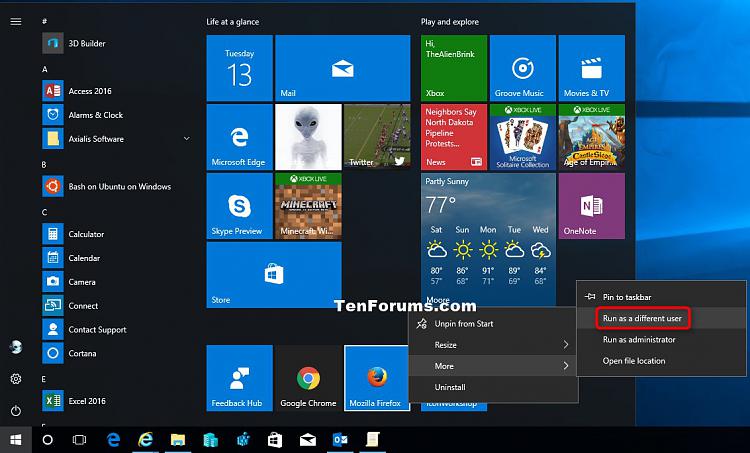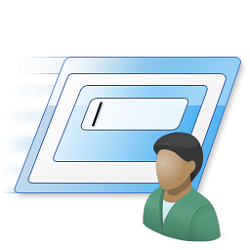How to Add or Remove 'Run as different user' Context Menu on Start in Windows 10
The Run as different user context menu allows a user to run .bat, .cmd, .exe, .msc, and .msi files with different permissions than the user's current logon provides.
If added, you will need to right click or press and hold on a .bat, .cmd, .exe, .msc, or .msi file on Start or in All apps, and click/tap on More to see the Run as different user context menu item.
When the Run as different user context menu is used, it will prompt the user to enter the user name and password credentials to use.
This tutorial will show you how to add or remove the Run as different user context menu in Start for all users in Windows 10.
You must be signed in as an administrator to be able to add or remove this context menu.
If the user you use with "Run as different user" doesn't have the appropriate permissions to access the file, then you will get an access is denied type error message like below.
- Option One: To Add or Remove "Run as different user" Context Menu on Start using a REG file
- Option Two: To Add or Remove "Run as different user" Context Menu on Start using Group Policy
EXAMPLE: "Run as different user" context menu on Start and All apps

The downloadable .reg files below will add and modify the DWORD value in the registry keys below.
HKEY_CURRENT_USER\Software\Policies\Microsoft\Windows\Explorer
HKEY_LOCAL_MACHINE\SOFTWARE\Policies\Microsoft\Windows\Explorer
ShowRunAsDifferentUserInStart DWORD
0 or (delete) = Remove
1 = Add
1. Do step 2 (add) or step 3 (remove) below for what you would like to do.
A) Click/tap on the Download button below to download the file below, and go to step 4 below.
Add_Run_as_different_user_on_Start.reg
Download
This is the default setting.
A) Click/tap on the Download button below to download the file below, and go to step 4 below.
Remove_Run_as_different_user_on_Start.reg
Download
4. Save the .reg file to your desktop.
5. Double click/tap on the downloaded .reg file to merge it.
6. When prompted, click/tap on Run, Yes (UAC), Yes, and OK to approve the merge.
7. Restart explorer, sign out and sign in to Windows, or restart the PC to apply.
8. You could now delete the downloaded .reg file if you like.
The Local Group Policy Editor is only available in the Windows 10 Pro, Enterprise, and Education editions.
All editions can use Option One above.
1. Open the all users, specific users or groups, or all users except administrators Local Group Policy Editor for how you want this policy applied.
2. In the left pane, click/tap on to expand User Configuration, Administrative Templates, and Start Menu and Taskbar. (See screenshot below)
3. In the right pane of Start Menu and Taskbar, double click/tap on Show "Run as different user" command on Start to edit it. (see screenshot above)
4. Do step 5 (remove) or step 6 (add) below for what you would like to do.
A) Select (dot) either Not Configured or Disabled, click/tap on OK, and go to step 7 below. (see screenshot below)
Not Configured is the default setting.
7. When finished, you can close Local Group Policy Editor if you like.
That's it,
Shawn
Related Tutorials
- How to 'Run as different user' in Windows 10
- How to Add or Remove 'Run as different user' Context Menu in Windows 10
Add or Remove Run as different user on Start in Windows 10

Add or Remove Run as different user on Start in Windows 10
How to Add or Remove 'Run as different user' Context Menu on Start in Windows 10Published by Shawn BrinkCategory: Customization
25 Sep 2018
Tutorial Categories


Related Discussions






